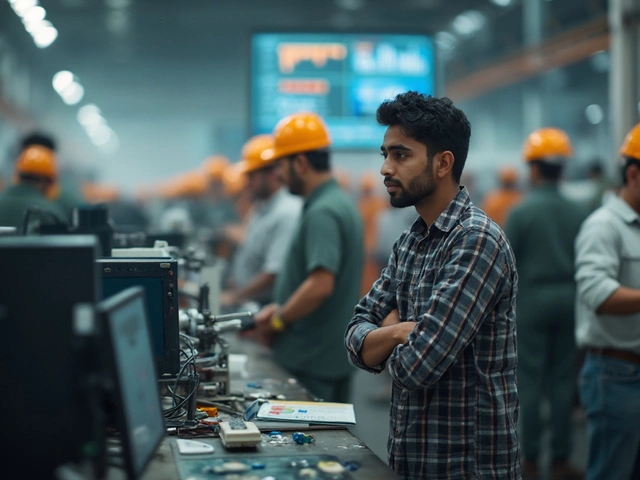Ask someone what local manufacturing means, and you’ll probably get a range of answers. Most people just think of making products nearby instead of shipping them across the world. But there’s more to it, especially when governments get involved.
Local manufacturing is all about producing goods in your own city or country, supporting local workers, and keeping business close to home. Why does this matter? Well, when stuff is made nearby, it often gets to you faster, sometimes costs less, and actually helps people get and keep jobs in your area. For governments, pushing for more local factories and workshops can make a region more stable—less dependent on other countries, and able to respond quickly when something goes wrong in the global market.
This isn't just a theory. From tax breaks for small factories to special loans for tech startups, government schemes are popping up everywhere, trying to jump-start local production. If you're wondering what all these programs mean for regular folks or small business owners, it boils down to more chances to start something new, land a better job, or even find a niche product you can’t buy from big international brands.
- Breaking Down Local Manufacturing
- How Government Schemes Support Local Production
- Why Local Manufacturing Matters for You
- Common Challenges and Smart Solutions
- Getting Involved: Tips for Businesses and Communities
Breaking Down Local Manufacturing
Local manufacturing is pretty simple at its core. It just means things are made where you live, instead of somewhere far away. This could be a small family-run factory, a neighborhood bakery churning out bread, or a mid-sized company assembling electronics a few towns over. The key point is that the products don't have to travel half the globe to reach you.
The push for local manufacturing isn't new, but it's getting a ton of attention lately. Especially after all those supply chain hiccups from the COVID-19 pandemic, a lot of countries realized they couldn't always count on goods arriving from overseas. Sometimes cargo stuck at ports meant empty shelves. With stuff made local, there's a lot less waiting and worrying about what might go wrong somewhere else.
When you talk about local manufacturing, you’re also talking about supporting local workers and businesses. According to the Organisation for Economic Co-operation and Development (OECD), small and medium-sized manufacturers account for almost 70% of jobs in a typical city’s manufacturing sector. That’s a huge slice of the employment pie.
- Goods made locally often have a smaller carbon footprint because they don’t need to be shipped long distances.
- Local manufacturing can respond quickly to changes in demand—no need to wait months for international shipments.
- It encourages unique local products, rather than the same stuff available everywhere.
Governments love it because local factories and workshops keep money cycling through the local economy. Every wage paid and every purchase made locally helps strengthen the whole community. Plus, when supply chains get hit with a curveball, local businesses are usually first in line to help out or fill in the gaps.
| Country | % of Goods Produced Locally (2023) |
|---|---|
| USA | 78% |
| India | 85% |
| Germany | 73% |
If you see a "Made in [Your Country]" tag, you're looking at local manufacturing in action. It's not just about patriotism—it's about jobs, stability, and even making sure your favorite products are always on the shelf.
How Government Schemes Support Local Production
So, how do government schemes actually make local manufacturing work? For starters, a big move is offering tax cuts or rebates to small and medium-sized manufacturers. In India, the 'Make in India' program is a well-known example. It gives tax breaks and fast-tracked permits to companies who set up factories within the country. This helps businesses lower costs and encourages new local players to step in.
There’s also direct funding. Many governments hand out grants or low-interest loans for buyers to upgrade machinery, hire new staff, or invest in new technology. For example, in the UK’s Local Manufacturing Fund, businesses could grab grants worth up to £1 million if they promised to create jobs and use local suppliers. Small companies get a leg up, and local workers benefit too.
Training is another game-changer. Some programs pay for shops or factories to teach their staff new skills, especially when moving from old-school methods to modern, more efficient ones. In the US, the Manufacturing Extension Partnership connects smaller businesses with experts, helping them compete with the big guys on home turf.
Another common support is help with finding buyers. Local governments sometimes set up platforms or organize trade shows to match local producers with buyers in their city or state. This means small brands stand a better shot against larger, imported goods.
- Tax incentives: Lower taxes for businesses that manufacture locally.
- Direct funding: Grants and loans for equipment, training, and growth.
- Training programs: Upskilling workers for new roles and technology.
- Market access: Linking local producers to buyers, public procurement schemes.
You might be surprised by the numbers. For instance, according to a UK government report from 2024, towns that took part in local manufacturing schemes saw factory job numbers rise by 18% in just two years. This domino effect leads to more cash circulating in the area—and often, better goods and services for everyone who lives there.

Why Local Manufacturing Matters for You
Think local manufacturing sounds like something only politicians or big business owners care about? It's actually about your everyday life. When products are made just around the corner, you see real effects: jobs stay in the community, delivery times drop, and your purchases support people nearby instead of just boosting some company far away.
Let’s get concrete. During the COVID-19 pandemic, countries that made their own masks and medicines had an easier time protecting their people. If you needed a bike during the shipping container mess in 2021, you probably paid more—unless someone was building them nearby. Making stuff locally means less sweat over shipping delays and weird shortages.
On the job front, local manufacturing isn’t just about factory work—it’s design, sales, delivery, and repair. According to the U.S. Bureau of Economic Analysis, every new manufacturing job supports up to four more jobs in other fields. That means when your town gets a new factory, the grocery store, the gas station, and the hardware shop all feel the boost.
- Faster delivery: You get what you order in days, not weeks.
- Support for local businesses: Money you spend stays close to home.
- Better quality control: It’s easier to keep an eye on how things are made nearby.
- Greener choices: Fewer miles shipping stuff means less pollution.
| Benefit | Example |
|---|---|
| Job creation | 76% of new manufacturers in India (2022) hired local workers* |
| Shorter supply chains | Local clothing brands cut delivery time by up to 60% |
| Boost to local economy | £1 spent on UK-made products returns £2.50 to local communities |
*Based on a report by India’s Ministry of Micro, Small, and Medium Enterprises.
So if you’re shopping or job hunting, checking for homegrown brands or government schemes promoting local makers could land you a better deal—and help your neighbors too. Next time you buy something, look at the label. That ‘Made in Your Town’ tag packs a bigger punch than most realize.
Common Challenges and Smart Solutions
Trying to ramp up local manufacturing sounds simple, but it’s got more bumps than you’d think. For starters, one of the biggest headaches is dealing with high costs. Machinery, raw materials, and skilled workers often cost more than folks expect. According to a 2023 study from the Manufacturing Institute, small businesses in the US named startup costs as their main roadblock to scaling local production.
Another problem? It’s tough finding trained workers. Not everyone has the skills needed to use modern machines, especially as tech gets more advanced. That puts extra pressure on businesses to either train people themselves or pay higher wages to lure talent. Plus, local rules and permits are a maze. Factories have to jump through all kinds of government hoops, which slows everything down.
Even with government help, small businesses sometimes miss out on key funding. Programs meant to help often have confusing paperwork or tight deadlines. Take India’s Make in India scheme—lots of companies reported they didn’t know how to apply, or ran out of time after reading the requirements.
Luckily, there are ways to work around these hassles. Here’s what works on the ground:
- Shared spaces like co-manufacturing hubs help small businesses split costs for equipment and reduce overhead.
- Many local trade schools and online bootcamps have started offering quick, targeted training for modern manufacturing skills.
- Smart use of digital tools (think inventory software or 3D printing) can lower costs and speed up production.
- Local chambers of commerce and business councils now host regular workshops that break down complex government grant applications, making it much easier for folks to get support.
Check this out—according to a 2024 survey by the Federation of Small Businesses, companies that joined local workshops had a 40% higher chance of securing government grants than those that tried going it alone:
| Approach | Success Rate (%) |
|---|---|
| Attended Grant Workshops | 68 |
| Did Not Attend | 28 |
So, while the road to building up local manufacturing can be bumpy, smart moves and a bit of teamwork go a long way.

Getting Involved: Tips for Businesses and Communities
Jumping into local manufacturing might sound huge, but there are practical ways for both businesses and communities to get started. You don’t need a massive factory to take the first step.
For businesses, the easiest way is to tap into government schemes designed specifically to boost manufacturing. In India, the Production Linked Incentive (PLI) scheme gives direct financial perks for hitting certain manufacturing targets. In the US, the Manufacturing Extension Partnership (MEP) helps small and midsize businesses with everything from training to tech upgrades.
Here’s what you can do right now:
- Check your local, state, or national government websites for manufacturing grant programs or tax credits.
- Form partnerships with local suppliers to keep your supply chain tight and flexible.
- Join local business associations—they usually know who’s hiring, what resources are available, and where to find funding.
- Think small at first: custom parts, packaging, assembly, or even digital manufacturing through 3D printing.
- Watch out for coworking spaces and community workshops (makerspaces). These can cut your startup costs, and you’ll meet people on the same path.
Communities can help too, and not just by cheering from the sidelines. Local councils can set up fairs and "buy local" campaigns. Schools can add simple manufacturing skills to their classes so kids don’t see shop class as old-school. When local government and schools work together, more young people see local manufacturing as a solid career—not just a fallback.
Want the numbers? According to a 2024 report from the National Association of Manufacturers, regions with local manufacturing hubs saw job growth rates 18% higher than regions without, just in the last two years.
| Action | Impact |
|---|---|
| Joining government schemes | Access to funding and exclusive incentives |
| Partnering with local suppliers | Faster deliveries, resilient supply |
| Training through community workshops | Cheaper skills development for staff |
Most of all, keep your ear to the ground. New policies and schemes come out nearly every year. Signing up for industry updates and talking to others trying the same thing keeps your edge sharp. If you’re business-minded or community-focused, now’s a good time to get a piece of the local manufacturing action.







Write a comment